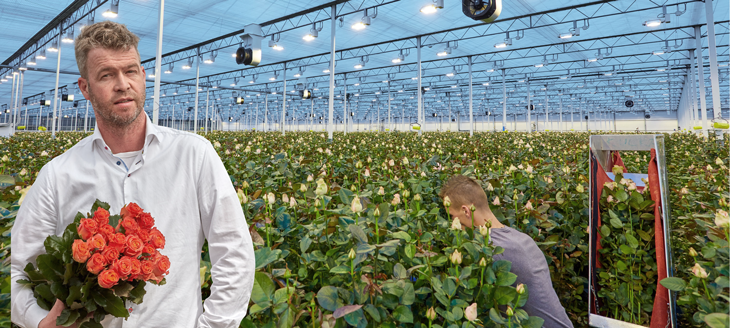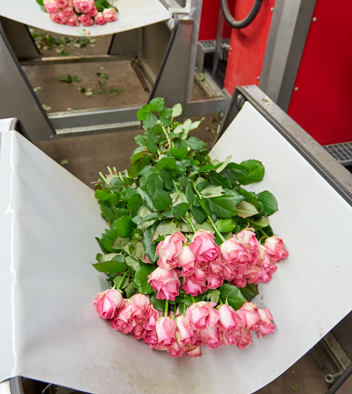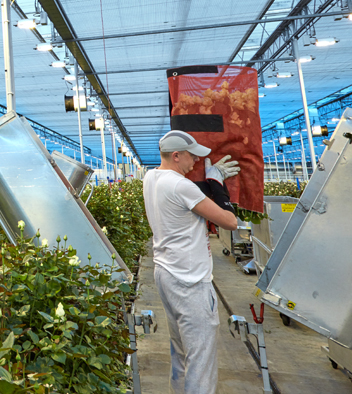Internationalizing boosts grower's business
Van den Berg Roses has nurseries in The Netherlands, Kenya and China. Each location has its own approach and production procedures in response to the market segment for which its products are intended. The company’s greenhouses in the Netherlands use very intensive cultivation methods that include the need for high light levels. Gavita is helping Van den Berg find ways to keep on perfecting its lighting.
Since 2000, the acreage devoted to growing roses in the Netherlands has decreased by 70%. During the same period, the supply of roses from Africa has increased by 270%. Around 2004, Arie van den Berg found his answer to the growing African competition: ‘If you can’t beat ’em, join ’em.’
He then established a nursery in Naivasha, Kenya that now covers over 170 acres. ‘Around 2004, we noticed a sharp rise in our energy and labor costs and, thus, in our cost price. Africa may be far from the European market but it has low energy and labor costs’, he says. ‘Just as important, however, is that our assortments supplement each other: the Kenyan roses are sold in supermarkets while the Dutch roses are intended for a higher market segment. This total package allows us to serve the European market – increasingly by means of direct sales. We also have our own logistics department.’

Prospects in the Netherlands
Van den Berg still sees prospects for growing roses in the Netherlands. Parallel with the expansion in Africa, cultivation at the two locations in Delfgauw (together: 30 acres) has been greatly intensified to produce many more pounds of product per square foot. Achieving this requires the perfect interaction among all the climate factors: light, temperature, CO2 and relative humidity. The nine rose varieties receive continuous light. These varieties were selected for optimum performance under this lighting regime and its high light intensity (200 µmol/m2/s). ‘The lamps never go entirely out during the winter. During the other seasons, they are turned on when solar radiation levels drop below 200 µmol/m2/s’, says the owner. This is growing at the upper limits of what’s possible. It requires the perfect synchronization of light and temperature, which makes the Quality Monitoring System (QMS) from Delphy very useful. ‘But we’ve given this our own special twist. When you admit more light, you can also up the temperature. We adjust the temperature during a two-day integration process as based on the quantity of assimilates that have to be processed’, he says.



Light distribution
This precision cultivation is made even more feasible when the grower can fully rely on the lighting system. ‘In the past, we never looked that closely at factors like light distribution. Based on Gavita’s calculations, though, it really does make a difference. They determined the best possible lamp layout for us. We are also frequently in touch with each other about new developments in reflectors, lamps and software control programs’, says Van den Berg. A number of the luminaires are periodically measured to monitor their light emission. ‘This is in both our interests. We’re always looking for an even better lighting system while Gavita gets a lot of data collected under practical conditions. We’re also both involved in conducting practical tests on new systems. All the measurements provide us with a lot of information; we used to replace lamps based on their age, but now it’s based on their performance. We can also see the negative impact that accumulated dirt and dust can have on the reflectors.’ In addition to light measurements, several crop measurements are taken: light intensity is compared with expected and realized growth. This reveals how much light the crop can utilize for production purposes. ‘We are very pleased with our collaboration with Gavita. We’re getting very good quality for our money, and we appreciate the contacts we have with them’, he says.
Developments in China
The nursery in Africa has no lighting system, and Van den Berg does not expect to add one in the future. Things are different, however, in China. Although lighting would not be profitable there yet, developments are moving swiftly in this direction. This is also why the company wanted to locate there. ‘During an excursion around Kunming, we saw many opportunities there. Horticulture is developing rapidly in China, and both the local market as well as Japan and Australia offer many business opportunities. This, and the fact that we noticed that the Chinese aren’t that good at growing roses yet, were factors in our decision to grow them ourselves there together with a local partner.’ The company now has about 50 acres in cultivation, and this number is increasing. To supply buyers with a total package, they grow not only roses but also orchids, anthuriums and hydrangeas. ‘This is a huge market, and we want to be its number one producer of flowers and plants. Quality is also important in China. This requires not just perfect growing conditions but also refrigerated conditions in the distribution chain.’ Now, due to the sharp drop in energy costs, growing roses in the Netherlands has the wind in its sails again. ‘We want to promote ourselves even more in the upper end of the market. Developments in lighting are making it possible to achieve even more µmol per Watt so that we can produce even more efficiently’, he says.
